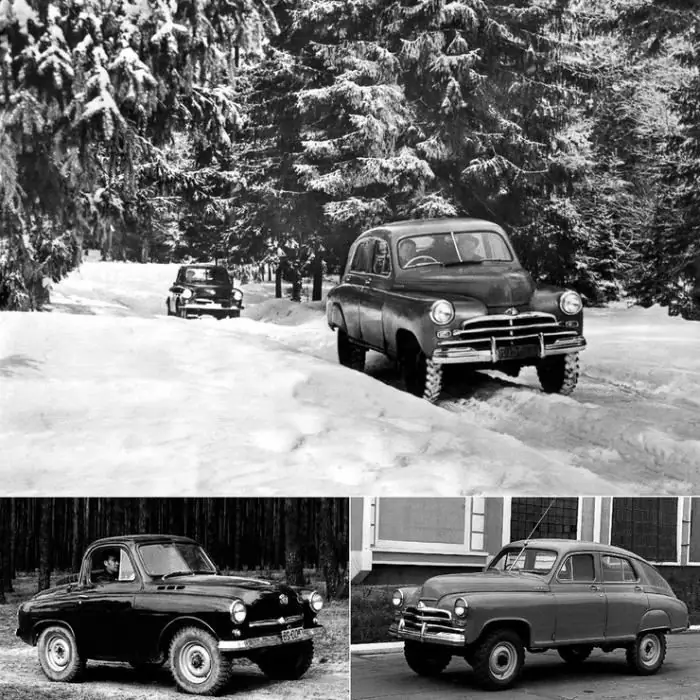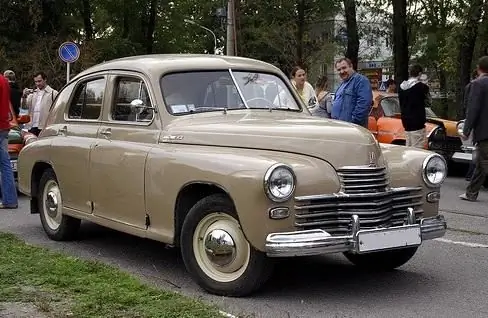2025 Author: Erin Ralphs | [email protected]. Last modified: 2025-01-22 21:14:12
"Victory GAZ M20" - the legendary Soviet car, which was in serial production from 1946 to 1958. A total of 236,000 cars were produced.

New car project
The Gorky Automobile Plant received a directive to create a new passenger car at the beginning of 1943. The main design work was carried out in the department of the chief designer A. A. Lipgart. At that time, there was a practice of manufacturing tooling for the production cycle abroad, mainly in American firms. However, at some point, the chief designer took the initiative and instructed the design bureau to make their own, domestic development.
So there was a project to create a Soviet passenger car, which received the name "Victory GAZ M20". In a short time, the chassis was calculated, the mass and center of gravity were distributed. The engine was carried far forward, it was above the front suspension beam. Due to this, the cabin became more spacious, it became possible to rationally distribute passenger seats.
As a result, the weight distribution reached an almost perfect ratio, with 49% on the front axle and 51% on the rear axle. The design continued, and after a while it turned out thatmodel "GAZ M20 Pobeda" has exceptional aerodynamic performance due to the shape of the body. The front end smoothly entered the flow of oncoming air, and the rear of the car, as it were, did not even participate in aerodynamic tests, the resistance of the body to air masses in the area from the windshield to the rear bumper was so low. Special sensors marked the number of units from 0.05 to 0.00.

Presentation
Several samples of cars with different characteristics were presented in the Kremlin to the top leadership of the country in the summer of 1945. For serial production, a four-cylinder version of the Pobeda GAZ M20 was chosen. The first cars left the assembly line in June 1946, but many shortcomings were noted. Mass production of "Victory" began in the spring of 1947.
The machine has been continuously improved during the production process. Finally, a fairly efficient heater was installed, combined with a windshield blower, in October 1948 the car received new parabolic springs and a thermostat. In 1950, a manual gearbox from ZIM with a shift lever on the steering wheel was installed on Pobeda.

Modernization
The car went through a number of restylings. The result of the latter in 1955 was the unification of Pobeda with the army GAZ-69. The ultimate goal of this strange project was to create a Soviet all-terrain vehicle with a high level of comfort. The idea turned out to be unviable, because the resultturned out to be depressing. Nothing but a clumsy freak with huge wheels could be obtained.
Then, in 1955, a new modification of the third series appeared with a 52 hp engine, a multi-ribbed radiator grille and a radio receiver. The model was produced until 1958.
There were attempts to create an elegant convertible under the index "M-20B", more than 140 copies of such cars were produced. Mass production could not be established due to difficulties with the kinematics of the automatic extension of the canvas roof. For some reason, one side of the frame lagged behind the other, the roof structure did not open. Production had to be suspended.
At the end of the 50s, a small series of "M-20D" with a boosted engine with a power of 62 hp was launched at the Molotov Automobile Plant. These cars were intended for the KGB garage. At the same time, the assembly of the Pobeda began with a 90-horsepower six-cylinder engine from ZIM for the MGB / KGB. Why these departments needed high-speed cars is still unclear, but nevertheless they got them.
Engine
- type - gasoline, carburetor;
- brand - М20;
- cylinder capacity - 2110 cu. see;
- configuration - four-cylinder, in-line;
- max torque - 2000-2200 rpm;
- power - 52 hp at 3600 rpm;
- cylinder diameter - 82 mm;
- compression ratio - 6, 2;
- food - carburetor K-22E;
- cooling - liquid, forced circulation;
- gas distribution - camshaft camshaft;
- cylinder block -gray cast iron;
- cylinder head material - aluminum;
- number of bars - 4;
- max speed is 106 km/h;
- gasoline consumption - 11 liters;
- fuel tank capacity - 55 liters.

Tuning "GAZ M20 Pobeda"
Because the "M20" is a machine from the distant past and more than 60 years have passed since its production, the model is today an interesting object for transformation. Tuning "GAZ M20 Pobeda" promises to be an exciting creative process.
"Victory" in miniature
Currently, the Pobeda GAZ M20 magazine is being published, which offers an interesting creative project. From issue to issue, the publication provides materials for assembling an exact copy of the legendary passenger car. The project is called "GAZ M20 Pobeda 1:8". Everyone can take advantage of the offer and assemble an exact copy of the car in 1:8 scale. The model will turn out to be large in comparison with ordinary miniatures, but the identity with the original is almost one hundred percent. The headlights of the model glow due to built-in diodes.
Recommended:
Car warranties. Car warranty repair period

Any motorist, purchasing a vehicle from an authorized dealer or in a specialized salon, in the event of a malfunction, expects to be repaired under warranty. This will save your budget and save you from unplanned expenses. After all, even a new car, like any technology, can break down
"Victory" GAZ-M72 - the pride of the Soviet car industry

Listen to how proudly “Victory” sounds. Nikita Khrushchev played a role in the history of the creation of this legendary Soviet car GAZ-M72. In 1954, he proposed to modernize the GAZ-69. That is, the car should have become more comfortable. As a result, the secretaries of the rural regional committees of the CPSU, as well as the chairmen of the advanced collective farms, were able to get service SUVs. But the military also had an interest in this car
ZIL-158 - city bus of the Soviet period

The city bus ZIL-158 was produced from 1957 to 1960 at the Likhachev plant. From 1959 to 1970, production continued at the Likinsky plant in Likino-Dulyovo, Moscow Region
K750: motorcycle of the Soviet period

In the USSR, heavy motorcycles appeared in the thirties. The first model - M-72 with a sidecar - was a real breakthrough. And when after it they developed the K-750, an even more perfect motorcycle, the Soviet society got a reason to be proud of the achievements of the auto and motorcycle industry
ZIL 114 - the legendary Soviet limousine

ZIL 114 is a luxury car produced in the USSR in the 70s. Its distinctive feature was an elongated body, which could accommodate up to 7 people. At one time, ZIL 114 transported all the highest ranks of the USSR and was the most prestigious car in the country

